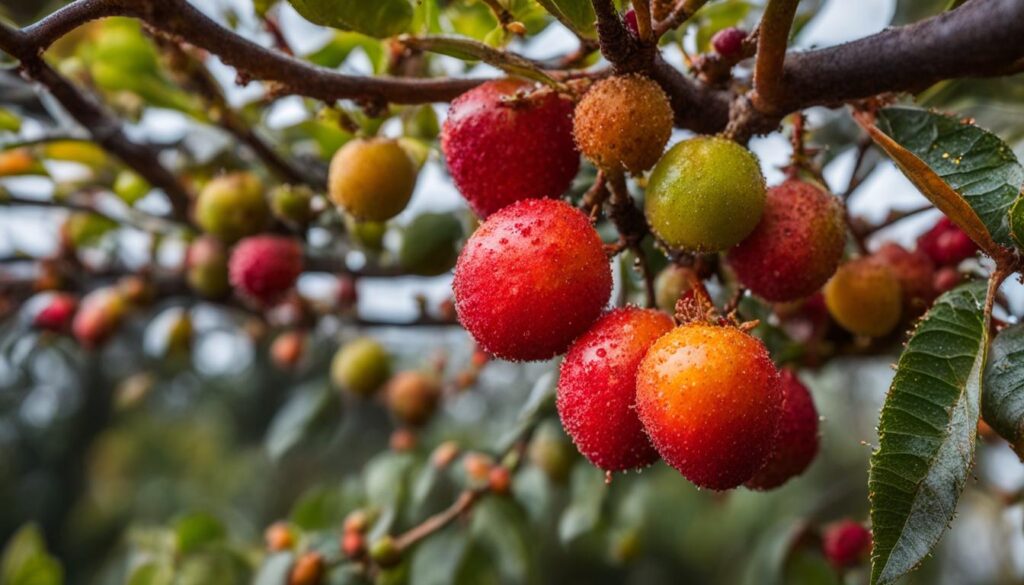Applying dormant oil sprays to fruit trees in late winter or early spring is a proactive measure to control overwintering pests, larvae, and eggs. This practice enhances pest control during the growing season and helps maintain the health and productivity of fruit trees. By following the recommended guidelines for application, fruit tree owners can effectively protect their trees from damaging pests and ensure a bountiful harvest.
Key Takeaways:
- Dormant oil sprays provide an effective method for controlling overwintering pests on fruit trees.
- Application should take place in late winter or early spring before bud break.
- Thorough coverage of all branches and trunk surfaces is essential for optimal results.
- Temperature plays a crucial role, and application should be avoided in temperatures below 40ºF.
- Effective pest control during the growing season relies on proper application of dormant oil sprays.
The Best Time to Apply Dormant Oil Sprays
When it comes to controlling overwintering pests on fruit trees, timing is crucial. The best time to apply dormant oil sprays is in late winter or early spring. This strategic timing allows for maximum protection against overwintering pests and their eggs, setting the stage for effective pest control during the upcoming growing season.
To ensure the effectiveness of dormant oil sprays, it is important to avoid spraying when temperatures drop below 40ºF. The oil needs sufficient warmth to penetrate and suffocate pests and their eggs. Applying the spray during milder weather guarantees optimal results and reduces the risk of damage to the trees.
By applying dormant oil sprays during late winter or early spring, gardeners can improve the health and productivity of their fruit trees by eliminating overwintering pests and preventing infestations. This practice is especially beneficial for fruit trees, as they are vulnerable to various pests during their dormant period.
Tips for Applying Dormant Oil Sprays

When it comes to applying dormant oil sprays, following a few key tips can help ensure optimal effectiveness. By taking these measures, you can enhance the control of overwintering pests and protect your fruit trees.
1. Shake Well and Follow Instructions
Before mixing the dormant oil spray with water, make sure to shake the product well. This ensures that the oil is properly distributed and mixed. Additionally, it is crucial to read and follow the instructions provided by the manufacturer. These instructions often include specific mixing ratios and dilution guidelines, which are essential for achieving the desired results.
2. Ensure Thorough Coverage
Thorough coverage is vital when applying dormant oil sprays. Be sure to apply the spray to the entire surface of branches and trunk, including the undersides of branches. This comprehensive coverage ensures that the oil reaches all potential hiding spots for overwintering pests, such as larvae and eggs. By targeting these areas, you effectively disrupt the pests’ life cycles and minimize their impact during the growing season.
Remember, dormant oil sprays work by suffocating and smothering pests, so it is crucial to achieve thorough coverage to maximize their efficacy.
3. Supplement with Additional Treatments if Needed
In some cases, applying dormant oil sprays may not provide complete control over certain pests. If you encounter difficult-to-control pests or notice persistent infestations, consider supplementing your treatment with additional pest control methods. Consulting with a professional arborist or horticulturist can help you identify the best course of action for your specific situation.
4. Monitor and Repeat Applications as Necessary
Monitoring the effectiveness of your dormant oil spray application is key to ensuring long-term pest control. Check your fruit trees regularly for signs of pest activity and assess the overall health of the trees. If necessary, repeat the application of dormant oil sprays according to the recommended schedule. Repeated applications help maintain control over pests throughout the season and contribute to the overall health and productivity of your fruit trees.
By following these tips for applying dormant oil sprays, you can effectively protect your fruit trees from overwintering pests and optimize their growth and yield.
| Tips | Benefits |
|---|---|
| Shake well before mixing | Proper distribution of oil |
| Follow instructions for mixing ratios | Optimal dilution for effectiveness |
| Thoroughly cover branches and trunk | Reach all potential hiding spots for pests |
| Supplement with additional treatments if needed | Enhanced control for difficult pests |
| Monitor and repeat applications as necessary | Long-term pest control and tree health |
Targeted Pests Controlled by Dormant Oil Sprays
Dormant oil sprays have proven to be an effective method for controlling a variety of overwintering pests. By applying the oil during the dormant season, it offers a targeted approach to suppressing these pests and preventing infestations during the growing season. Some of the specific pests that can be controlled with dormant oil sprays include:
- Aphids
- Spider mites
- Lace bugs
- Cankerworms
- Plant bugs
When dormant oil sprays are applied, they suffocate the eggs of these pests and disrupt their life cycles, preventing them from causing damage to fruit trees and other susceptible plants. However, it is important to note that not all pests are targeted by dormant oil sprays, and careful observation of the specific pest’s life stage and location is necessary for effective treatment.
“Dormant oil sprays offer a targeted approach to controlling overwintering pests, helping to safeguard your fruit trees and plants from infestations during the growing season.”
It is crucial to identify the pests correctly before applying dormant oil sprays, as different pests may require alternative control methods. Thoroughly inspect your plants and trees to determine the presence of these pests and observe their behavior. This will aid in selecting the most appropriate treatment and ensuring effective control.
Comparative Table: Control Effectiveness of Dormant Oil Sprays on Specific Pests
| Pest | Control Effectiveness |
|---|---|
| Aphids | Highly effective |
| Spider mites | Effective against some species |
| Lace bugs | Effective |
| Cankerworms | Effective |
| Plant bugs | Effective |
As shown in the table above, dormant oil sprays have a high effectiveness in controlling aphids, lace bugs, cankerworms, and plant bugs. However, the control of spider mites may vary depending on the species. Some spider mites may be effectively controlled with dormant oil sprays, while others may require alternative treatments.
Dormant oil sprays provide an important tool in an integrated pest management approach, helping to manage overwintering pest populations and reduce the need for chemical insecticides. By understanding the specific pests that can be controlled with dormant oil sprays, you can take proactive measures to protect your fruit trees and ensure the health and productivity of your garden. Always follow the recommended guidelines for application to achieve the best results.
Factors Affecting Dormant Oil Spray Effectiveness

The effectiveness of dormant oil sprays can be influenced by several factors that should be considered for optimal results. Temperature, phytotoxicity, and plant sensitivity all play important roles in determining the effectiveness of these sprays.
Temperature:
The application of dormant oil sprays should be timed accurately based on temperature conditions. It is recommended to apply the spray when temperatures will remain above 40ºF (4.4ºC) for at least 24 hours. This ensures that the oil becomes effective in controlling overwintering pests and their eggs. Lower temperature applications have been found to have no phytotoxicity on certain plants, making them a safe and effective option even in colder climates.
Phytotoxicity:
Dormant oil sprays, when used improperly, can cause phytotoxicity on some plants. Plants with blue glaucous foliage or hairy leaves are often more sensitive to the oil and may require lower concentrations to avoid damage. It is crucial to carefully follow the product instructions and consider the plant species and its specific sensitivity to determine the appropriate concentration for application.
Plant Sensitivity:
Plants differ in their sensitivity to dormant oil sprays. While most fruit trees tolerate these sprays well, some ornamental plants and sensitive species may be adversely affected. Conducting a patch test on a small portion of the plant before full-scale application is recommended to assess sensitivity. This ensures that the desired pest control is achieved without causing unnecessary harm to the plants.
By understanding and addressing these factors, the effectiveness of dormant oil sprays can be maximized, providing efficient control against overwintering pests while minimizing any negative impact on plant health.
Limitations of Dormant Oil Sprays
While dormant oil sprays can be effective against many overwintering pests, they do have limitations. They rarely provide 100% control and may be less effective for difficult-to-control pests such as elongate hemlock scales. Proper identification of the targeted pest and understanding its life cycle is essential for determining the effectiveness of dormant oil sprays. Additionally, repeated applications may be necessary for optimal control.
| Limitations of Dormant Oil Sprays | Dormant Oil Spray Effectiveness | Difficult Pests |
|---|---|---|
| May not provide 100% control | Dependent on proper identification and understanding of pest life cycle | Elongate hemlock scales and other difficult pests |
| Repeated applications may be needed | Varying effectiveness based on pest susceptibility and infestation severity | |
| Effectiveness influenced by weather conditions and application timing |
While dormant oil sprays can be a valuable tool in pest control for fruit trees, it is important to understand their limitations. Targeting difficult pests, such as elongate hemlock scales, may require additional control methods beyond dormant oil sprays. Regular monitoring and proper identification of the targeted pest will help determine the effectiveness of the application. It may also be necessary to apply the spray multiple times, depending on the severity of the infestation. Additionally, external factors such as weather conditions and application timing can affect the overall effectiveness of dormant oil sprays. Considering these limitations and adapting control strategies accordingly will lead to more successful pest management in fruit tree orchards.
Dormant Oil Sprays and Spider Mite Control
Dormant oil sprays can be an effective method of controlling spider mites, particularly spruce spider mites and southern red spider mites, during the fall season. Applying dormant oil sprays in the autumn can help reduce the populations of these cool-season mites, providing effective control.
However, it is essential to achieve thorough coverage when using dormant oil sprays to ensure successful control. Oils have a physical mode of action and require direct contact with the pests to be effective. Therefore, it is crucial to apply the spray in a way that coats the spider mites and their eggs completely.
“Applying dormant oil sprays in autumn can significantly reduce the populations of spruce spider mites and southern red spider mites, providing effective control during the fall season.” – Dr. Emma Richards, Entomologist
It is important to note that other species of spider mites, such as the two-spotted spider mite, may require different control strategies. Therefore, careful identification of the specific spider mite species is necessary to determine the most effective approach.
Comparison of Spider Mite Control with Dormant Oil Sprays
| Spider Mite Species | Control Effectiveness with Dormant Oil Sprays |
|---|---|
| Spruce Spider Mites | Highly effective |
| Southern Red Spider Mites | Highly effective |
| Two-Spotted Spider Mites | Less effective, may require alternative control methods |
Overall, dormant oil sprays can be a valuable tool in controlling spider mites, particularly spruce spider mites and southern red spider mites, during the fall season. By ensuring thorough coverage and using the appropriate control strategies for the specific spider mite species, growers can effectively reduce their populations and protect their plants.
Dormant Oil Sprays and Armored Scale Control
Dormant oil sprays are highly effective in suppressing soft scale species, such as pine needle scale and tuliptree scales. However, they may not provide the same level of control for armored scale species. Armored scales, including euonymus scale and white prunicola scale, often require additional control measures to achieve satisfactory results.
When dealing with armored scales, it is crucial to monitor for their presence and consider alternative control options if necessary. While a single dormant oil treatment may not be sufficient, a combination of strategies can help manage these challenging pests effectively.
“Armored scales, such as euonymus scale, have a protective covering that makes them more resistant to dormant oil sprays. A comprehensive approach, including alternative control methods, is necessary for successful management of these pests.”
Alternative Control Measures
Although dormant oil sprays may not provide complete control of armored scales, several alternative measures can be employed to manage these pests effectively. Some of the recommended techniques include:
- Biological control: Introducing natural predators, such as ladybugs or lacewings, that feed on armored scales can help reduce their populations.
- Chemical insecticides: In severe infestations, targeted applications of insecticides may be necessary to control armored scales. However, careful consideration should be given to the potential impact on beneficial insects and the environment.
- Pruning and destroying infested branches: Removing heavily infested branches can help reduce the overall population of armored scales.
By combining these control measures with vigilant monitoring, growers can effectively manage the presence of armored scales and protect their fruit trees from potential damage.
| Common Armored Scale Species | Description | Control Measures |
|---|---|---|
| Euonymus Scale | Small, circular scales that infest a variety of woody plants, usually found on the undersides of leaves and stems. | – Biological control: Introduce natural enemies such as predatory beetles. – Chemical control: Targeted applications of insecticides. – Pruning and destroying heavily infested branches. |
| White Prunicola Scale | Flat, white scales that primarily infest stone fruit trees such as peach and plum. | – Biological control: Encourage natural enemies like parasitic wasps. – Chemical control: Careful applications of insecticides. – Pruning and removing infested parts of the tree. |
Image caption: Armored scales infesting a fruit tree. Monitoring and employing alternative control measures are essential for effective management.
Personal Experiences and Recommendations for Dormant Oil Sprays
When it comes to dormant oil sprays, personal experiences and recommendations can provide valuable insights into their effectiveness. Different individuals have reported varying levels of success with these sprays, highlighting the importance of finding the right approach for your specific needs.
Some users have found that specific brands and oil types with thicker viscosities deliver optimal results. These denser oils adhere better to the tree surfaces and provide longer-lasting protection against overwintering pests. Combining dormant oil sprays with other products, such as copper-based solutions, has also been recommended by some individuals to enhance their effectiveness.
It is crucial to choose tested and proven products and methods tailored to your local area and orchard. Experimenting with different oil sprays and closely monitoring the results can help you determine the most effective approach for controlling pests. By observing how the trees respond and assessing pest activity, you can fine-tune your strategy and achieve optimal pest control in your fruit trees.
Remember, personal experiences can provide valuable insights, but it is essential to consider individual orchard conditions and the specific pests you are dealing with. By combining personal recommendations with expert guidance from local horticulturists or extension services, you can make informed decisions and maximize the effectiveness of dormant oil sprays.
FAQ
Why should I apply dormant oil sprays to fruit trees?
Applying dormant oil sprays helps control overwintering pests, larvae, and eggs, improving pest management during the growing season.
When is the best time to apply dormant oil sprays to fruit trees?
Late winter or early spring is the ideal time to apply dormant oil sprays to protect against overwintering pests and their eggs.
What tips should I follow when applying dormant oil sprays?
Shake the product well before mixing with water, thoroughly cover all branches and trunk surfaces, and read and follow the instructions for specific mixing ratios and dilution.
Which pests can be controlled by dormant oil sprays?
Dormant oil sprays can effectively control a range of overwintering pests, including aphids, spider mites, lace bugs, cankerworms, and plant bugs.
What factors can affect the effectiveness of dormant oil sprays?
Temperature plays a crucial role, with applications best made when temperatures will remain above 40ºF for at least 24 hours. Some plants may be more sensitive to the oil, requiring lower concentrations.
What are the limitations of dormant oil sprays?
Dormant oil sprays do not provide 100% control and may be less effective against certain pests. Proper identification and understanding of the pest’s life cycle are essential for determining effectiveness.
Can dormant oil sprays control spider mites?
Dormant oil sprays can suppress certain spider mite species, such as spruce spider mites and southern red spider mites, if applied in the autumn. Thorough coverage is essential for successful control.
Can dormant oil sprays control armored scales?
Dormant oil sprays can suppress soft scale species but may not be as effective against armored scale species. Additional control measures may be necessary for satisfactory results.
What are some personal experiences and recommendations for dormant oil sprays?
Personal experiences vary, with some individuals finding success using specific brands and oil types with thicker viscosities. Experimenting with different sprays and monitoring results can help determine the most effective approach for controlling pests.

